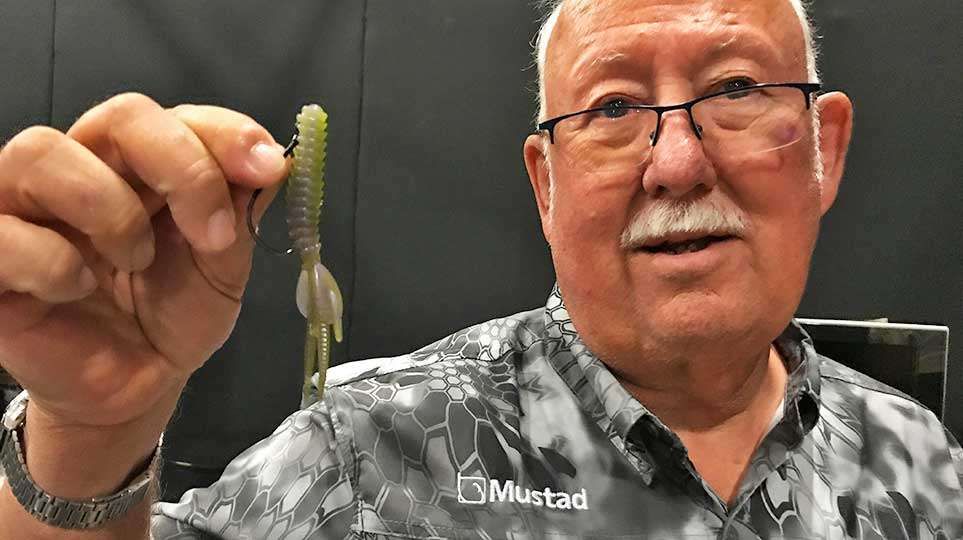
Editor’s note: This story came from a content conference B.A.S.S. had with key partners in the Little Rock studio of Bassmaster LIVE. Here are two more stories from that week: Abu’s Andrew Wheeler, T-H Marine’s Gene Eisenmann.
Harry Simmons, a life member of B.A.S.S. since 1978, knows way more about fishing hooks than you, probably more than most anybody in the world.
Fishing around the globe since his youth, the retired U.S. Air Force master sergeant, who worked as a supply specialist, has been hooked by hooks.
From numbers on a box, he knows what type of hook is inside. From listening to pro anglers and addressing their concerns, or from his personal needs, he’s designed 50 to 60 hooks in the Mustad stable. Some were designed for specific lure applications, like a jig or a crankbait.
In the hook category, Simmons is the most interesting man in the world, and how he even got into the business is interesting.
“Being in the right place at the right time,” he said. “I was a parts man in the military. Fish hooks have reference numbers. That’s a part number to me.”
While he began fishing for the likes of Calico bass with his father off the California coast when he was around 5, Simmons retired in bass country. His last duty assignment was at Whiteman Air Force Base in central Missouri, close enough to fish Truman Reservoir and Lake of the Ozarks regularly. He often visited Tiny Tackle Shop in Windsor.
“I’d tell the guy running it, Albert Watson, ‘What day you want to take off? I’ll cover for you,’” said Simmons, who added in lieu of pay he only wanted a “crankbait or a spinnerbait” from time to time.
Later Watson and John Pfenenger bought Shorty’s Hook Sales, which sells to manufacturers and retail shops across the globe at wholesale prices. Simmons lent his expertise when the men bought back huge boxes with thousands of fish hooks. He knew how to organize a warehouse and control that inventory.
Simmons ended up helping build Shorty’s into a profitable business. In seven years there, it turned its first million dollars then added a second million in another three years. In his best year, he sold 48.5 million hooks. During that time, he also had his hand in designing and convincing Mustad to build particular hooks that he knew would sell.
“I started there with the first needlepoint jig hooks Mustad ever made,” he said. “The spinnerbait hook I did is still the best selling on the market. I was having Mustad build a lot of fish hooks. I’m the reason why Mustad has Ultrapoint hooks today.”
Simmons said there are some finer points, pun intended, to designing something as small as the business end of a hook. He worked with engineers out of Singapore to iron out some flaws in the needlepoint, which became the Ultrapoint. He spoke of the minutiae involved in changing the cone angles of the point to make it stronger.
A tiny piece of metal can make a huge difference. That’s evidenced by Simmons’ latest innovation. A speck of lead and tin added at the bend of an offset shank is the working feature of Mustad’s Grip-Pin series, which keep plastics on hooks.
How Simmons came up with the idea was through personal failure years ago while fishing on Truman.
“I loved to drop a tube into cedar trees, and you get a little nibble and your tube slides down,” he said. “You have to reel it all the way back up, readjust it. Do that two or three times and your tube is shot, you missed the fish and took it out of the strike zone.”

A lot of what Simmons has designed has come from collaborations. He takes his experiences fishing all over the world – from moving a lot in his youth to his Air Force days – then listens to pros and tries to design a hook that addresses their issues.
Fishing central Missouri tournaments, Simmons got to know pros like Denny Brauer and Guido Hibdon, and he’d take in their thoughts on their vast fishing experiences.
“I would pay attention, and I knew what I wanted to fish with,” he said. “I listened to these pros. ‘This is what I see wrong, this is what I want to change.’ I’d hear the same thing from four or five of them. Denny likes this, Kevin (VanDam) likes that. A lot of the fish hooks I designed were from listening to conversations from the pros and putting it all together.”
VanDam came to Mustad almost 15 years ago asking them to solve an issue. KVD was actually cutting out segments of hooks and using wrap to hold plastics, but hand braiding each was cost prohibitive, even though the feature was in high demand.
“I kept thinking there’s got to be something better,” Simmons said. “I kept working on this Grip-Pin idea and finally figured out how to add that pin with a series of lead and tin in a certain combination.
“I figured out it had to be poured in precision molds made out of aircraft grade aluminum that are cut so precise on a CNC (computer numerical control) machine. We were pretty proud of how we figured out how to make that hold.”
It gave the industry a game-changing product, and another hook in Simmons’ and Mustad’s arsenal.
Memory of reference numbers blessing and curse
Simmons’ experience at spouting reference numbers in the military served him well in the hook business, starting at Shorty’s. He’d get a call and could quickly answer any request.
“I could spout those numbers off the top of my head,” he said. “It was almost a curse, actually.”
That knowledge is what helped build his relationship with Mustad. He went to a huge warehouse as Mustad general manager Kevin Lamontagne offered him a chance to buy box loads of hooks at discount. Simmons impressed him by knowing what was in the giant boxes by the reference numbers.
“I’d tell him what was in the box, and he couldn’t believe it,” Simmons.
Simmons’ then identified a box of gold treble hooks that were in high demand and clued in Lamontagne. There were enough to fill each man’s back orders.
“He liked me for my honesty,” Simmons said.
And Harry, who continues to get calls about identifying hooks today, has been hooking folks on Mustad ever since.





